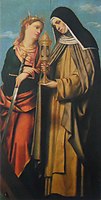Assumption Altarpiece
- View a machine-translated version of the Italian article.
- Machine translation, like DeepL or Google Translate, is a useful starting point for translations, but translators must revise errors as necessary and confirm that the translation is accurate, rather than simply copy-pasting machine-translated text into the English Wikipedia.
- Consider adding a topic to this template: there are already 3,070 articles in the main category, and specifying
|topic=will aid in categorization. - Do not translate text that appears unreliable or low-quality. If possible, verify the text with references provided in the foreign-language article.
- You must provide copyright attribution in the edit summary accompanying your translation by providing an interlanguage link to the source of your translation. A model attribution edit summary is
Content in this edit is translated from the existing Italian Wikipedia article at [[:it:Polittico dell'Assunta]]; see its history for attribution. - You may also add the template
{{Translated|it|Polittico dell'Assunta}}to the talk page. - For more guidance, see Wikipedia:Translation.

The Assumption Altarpiece was a 1529-1530 multi-panel painting by Moretto da Brescia. It is mainly oil on panel, although the two angels on the cornice are in tempera grassa verniciata.
The whole work was originally in the Basilica of Santa Maria degli Angeli in Gardone Val Trompia but was split up in 1805 and moved to the Pinacoteca di Brera in Milan.[1] All the panels remained there until 1812, when the two lower side panels (St Bonaventure and St Anthony of Padua and St Bernardino of Siena and St Louis of Toulouse) and three other paintings (one each by Boltraffio, Marco d'Oggiono and Carpaccio) were given to the Louvre in exchange for two paintings by Van Dyck and one each by Rubens, Jordaens and Rembrandt.[2]

Panels
Cornice
- Two Angels
Upper register
- Saint Jerome and St Paul
- Assumption of the Virgin
- St Catherine of Alexandria and St Clare of Assisi
Lower register
- St Bonaventure and St Anthony of Padua
- St Francis of Assisi
- St Bernardino of Siena and St Louis of Toulouse
-
 St Jerome and St Paul
St Jerome and St Paul -
 St Catherine of Alexandria and St Clare of Assisi
St Catherine of Alexandria and St Clare of Assisi -
 St Bonaventure and St Anthony of Padua (Louvre)
St Bonaventure and St Anthony of Padua (Louvre) -
 St Francis of Assisi
St Francis of Assisi -
 St Bernardino of Siena and St Louis of Toulouse (Louvre)
St Bernardino of Siena and St Louis of Toulouse (Louvre)
References
Bibliography (in Italian)
- Camillo Boselli, Il Moretto, 1498-1554, in "Commentari dell'Ateneo di Brescia per l'anno 1954 - Supplemento", Brescia 1954
- Pietro Da Ponte, L'opera del Moretto, Brescia 1898
- Luigi Falsina, Gemme artistiche triumpline, in "La valle Trompia", anno 7, Brescia 1930
- György Gombosi, Moretto da Brescia, Basel 1943
- Valerio Guazzoni, Moretto. Il tema sacro, Brescia 1981
- Pier Virgilio Begni Redona, Alessandro Bonvicino - Il Moretto da Brescia, Editrice La Scuola, Brescia 1988
- Adolfo Venturi, Storia dell'arte italiana, volume IX, La pittura del Cinquecento, Milano 1929
- v
- t
- e
- Enthroned Madonna and Child with Saint James the Great and Saint Jerome (1517)
- Christ with the Cross (1518)
- The Dead Christ Adored by Saint Jerome and Saint Dorothy (1520–1521)
- Holy Cross Standard (1520–1521)
- Standard of Our Lady of Mercy (1520–1522)
- Salvation Triptych (1521–1524 or 1527–1528)
- Our Lady of Mount Carmel (c. 1522)
- Assumption of the Virgin (1524–1526)
- Portrait of a Man (1526)
- Supper at Emmaus (c. 1526)
- Madonna and Child with Saint Roch and Saint Sebastian (c. 1528)
- Orzinuovi Altarpiece (1525–1530}
- Lament over the Dead Christ (1526–1530)
- Sant'Eufemia Altarpiece (1526–1530)
- Assumption Altarpiece (1529–1530)
- St Anthony of Padua with Two Saints (1530)
- St Justina of Padua with a Donor (c. 1530)
- Madonna and Child with Saint Martin and Saint Catherine (c. 1530)
- Massacre of the Innocents (1531–1532)
- Saint Anthony Abbot (1530–1534)
- Coronation of the Virgin Altarpiece (c. 1534)
- The Deaf-Mute Filippo Viotti's Vision of the Virgin Mary (c. 1534)
- Annunciation (1535–1540)
- The Assassination of Saint Peter Martyr (1535–1540)
- Portrait of a Gentleman with a Letter (1535–1540)
- Chiesa di San Giovanni Evangelista Organ Case (c. 1535)
- Madonna and Child Enthroned with Saints (1536–1537)
- Rovelli Altarpiece (1539)
- Adoration of the Shepherds with Saints Nazarius and Celsus (1540)
- Madonna and Child with Saints (Verona, 1540)
- Salomé (1540)
- Pralboino Altarpiece (1540–1545)
- Christ in Glory with Saint Peter and Saint Paul (c. 1540)
- Christ with the Eucharist and Saints Cosmas and Damian (c. 1540)
- Madonna and Child with Four Doctors of the Church (c. 1540–1545)
- Madonna and Child with Saints (London, c. 1540–1545)
- Madonna and Child with an Angel (c. 1540–1550)
- Christ with Moses and Solomon (1541–1542)
- Portrait of Fortunato Martinengo Cesaresco (1542)
- Luzzago Altarpiece (1542)
- Madonna and Child with Four Saints (c. 1543)
- Mystic Marriage of Saint Catherine (c. 1543)
- Pentecost (1543–1544)
- Supper in the House of Simon the Pharisee (1544)
- Christ with the Eucharist and Saints Bartholomew and Roch (c. 1545)
- Portrait of an Ecclesiastic (c. 1545)
- Christ and the Angel (c. 1550)













